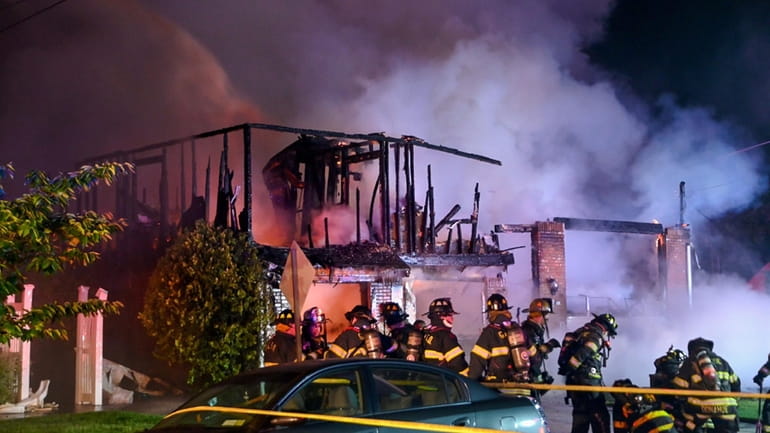New York tops states in fire deaths so far this year

Firefighters pour water on a fire that killed one woman and destroyed a home on Lafayette Street in Williston Park on May 23. Credit: Paul Mazza
Fires have killed more New Yorkers than residents of any other state through the first seven months of 2023, with 100 dead, according to statistics compiled by the U.S. Fire Administration.
Of the 1,305 fire deaths nationwide this year, the federal agency's latest figures show Long Island with three in Nassau and one in Suffolk.
Officials said there's good reason the numbers are low on the Island.
Despite having a largely volunteer firefighting force, Long Island has benefited from proactive education and awareness campaigns and stepped-up code enforcement, including safety inspections and mandates for working smoke detectors, officials said. Efforts by a growing number of volunteer departments to have firehouses staffed by round-the-clock "duty crews" have resulted in low fatalities and better outcomes.
WHAT TO KNOW
- Through the first seven months of 2023, 100 people have been killed in fires in New York State. Of that number, 71 occurred in New York City.
- Of the 1,305 fire deaths nationwide this year, Long Island has had four: three in Nassau and one in Suffolk.
- Officials credit the low number of deaths on Long Island to proactive education and awareness campaigns, stepped-up code enforcement, and efforts by a growing number of volunteer departments to have firehouses staffed around the clock.
"You'd like to have the number be zero," Nassau County Chief Fire Marshal Michael F. Uttaro said. "But, I'd like to think that the reason our numbers are low is because out here we do a lot more education and outreach. We push smoke detectors.
"We push our fire marshals when it comes to the inspection of things like multiple residences, identifying places with fire alarms and smoke detectors that either aren't there or aren't working," Uttaro said. "We work with the American Red Cross, social media, do all sorts of awareness campaigns. … Like with police and enforcement and education of seat belt laws. It's the same thing in the fire world."
A Suffolk official agreed.
"I don't think it's luck," Suffolk County Fire, Rescue and Emergency Services Deputy Coordinator Jamie Atkinson said of the low number of fire deaths in Nassau and Suffolk. "There's multiple factors that go into the equation, and I think it's not only that we do education and awareness programs on fire safety, but also that we have a lot of fire houses.
"And every community has an engine, every community has a pumper. Every community has an ambulance, EMS," he added. "That helps with things like response times, and it helps with the outcome once we do respond."
On their face alone, the statistics are alarming — New York, with 19.4 million people, saw more fire deaths than states with larger populations. California had 57 deaths from a population of 39.24 million residents, based on 2020 U.S. Census figures. Texas had 72 fire deaths and a population of 29.53 million people.
Long Island has almost 3 million people, with 1.4 million in Nassau and 1.5 million in Suffolk.
Of the state's 100 fatalities, 71 occurred in New York City. The U.S. Fire Administration and FDNY said of those, 23 were in residences where no smoke detector was present; eight were in residences where a detector was present but not working; in another eight it was unclear if the detectors were working; and in another inspectors were unable to determine if there'd been a working detector in the residence.
In just 19 cases were inspectors able to determine there'd been a working smoke detector on-site.
Many of the fires statewide, though, had multiple victims: Five children, all age 10 and under, killed in a fire in Buffalo in January; five dead, including two children, ages 13 and 4, in a house fire in Spring Valley in March; a Brooklyn fire that killed three in April; another that killed three in May; and a Manhattan fire that killed four in June and was tied to a faulty e-bike battery charger, according to the FDNY.
Fire death rates lower in NY
The U.S. Fire Administration statistics show that New York in general has much better survival rates per 1,000 residential fires than the national average.
On average, those national statistics show, there were 2,745 deaths in residential fires a year between 2018-2020. Of those, 45% occurred between 11 p.m. and 7 a.m., 27% in bedrooms, with 14% overall attributable to smoking and another 20% attributable to carelessness.
In just 16% of the fatal fires were inspectors able to determine there was a working smoke detector in the home.
In New York, the rate of fire deaths is 0.9 per 1,000 residential fires, and the injury rate 15.7 per 1,000. Nationally, the U.S. Fire Administration said, the numbers are 6.5 and 20.9.
Of the fatal fires this year in Nassau County, Uttaro said one involved an elderly victim, another involved an invalid who was trapped and a third involved a victim who had successfully evacuated the home — then went back inside to look for her dog. That fire, in Williston Park, injured seven. In Suffolk, the fatal fire happened on Feb. 24 in Islip, according to the U.S. Fire Administration.
"Absolutely, the most important thing you can do for yourself is to have working smoke detectors," Firefighters Association of the State of New York secretary and spokesman John D'Alessandro said in June.
"Working smoke detectors, working carbon monoxide detectors — those are key, especially since often it's the CO that incapacitates people," D'Alessandro, a Ronkonkoma native, said of the carbon monoxide. "The second critical thing is that building codes are being followed and that buildings are inspected. Codes are important."
Of equal importance, when it comes to surviving a fire, D'Alessandro said, is to be prepared for that worst-case scenario.
"Have a plan," he said. "Especially if you have kids, but no matter what, plan ahead. Know the evacuation routes. Have a common rendezvous point, so you know if everyone has gotten out or not. … It really is a matter of seconds where you can go from a kitchen fire or a room fire to a point where you might not be able to escape. You can't imagine just how chaotic it can be.
"The quicker you can get out, the safer you are."
Drop in volunteer firefighters
Long Island fire officials said despite all the proactive measures, which include making smoke detectors available at cost, as well as some departments and outreach programs providing installation, one major hurdle has been staffing.
Officials at FASNY said the numbers of men and women firefighters in the state volunteer corps had gone from about 120,000 statewide in the early 2000s to about 80,000 post-pandemic.
To that end, Nassau has begun an online campaign with a site called Nassau's Bravest, and Suffolk has started Suffolk's Bravest. Uttaro said since the site launched this year, Nassau already had seen more than 2,000 visits, with more than 100 applicants filing paperwork with 71 departments.
And the junior firefighter programs in both counties have drawn in new people as well.
"It's still a battle," Uttaro said, "but we're trying."
The bottom line, Uttaro, Atkinson, D'Alessandro and other officials agree is that you can't have the attitude that this can't happen to you.
"People think, 'It's never going to happen to me,' until it does," D'Alessandro said. "The best fire is a fire that never happens. The next-best one is the one you get out of and survive."

